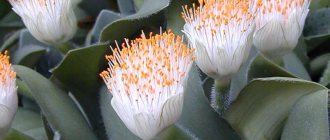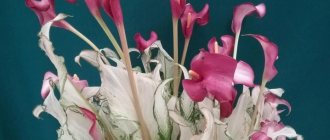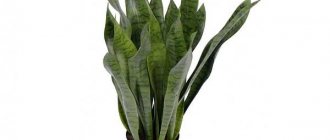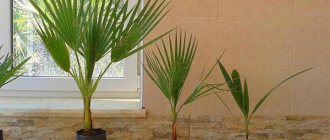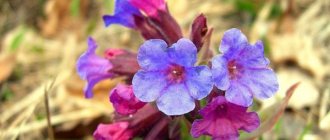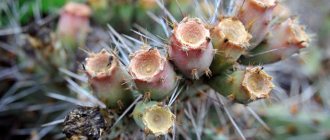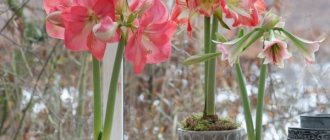Hemanthus is a perennial flower of the amaryllis family. This bulbous evergreen plant, due to the shape of the leaves, was popularly called “deer tongue.”
The inflorescences are shaped like an umbrella on a long stalk, consisting of many small flowers forming a large ball. The only drawback of this luxurious plant is its peculiar smell.
Despite this, deer tongue has an amazing ability to grow all year round and delight with its wonderful appearance. Therefore, many amateur gardeners decorate their interiors with this plant.
Hemanthus is native to South Africa.
Botanical description
The homeland of this simple but lovely flower is the tropical jungle of the African continent. It was brought to Europe by its discoverers during the Age of Enlightenment in the 18th century. Lovers of wonders liked it thanks to its simple care.
Hemanthus unites a large genus of the Amaryllis family and belongs to the monocotyledonous flowering plants. Its name means blood-red flower in Latin, referring to the bright and large inflorescence - the French discoverer Joseph de Tournefort was the first to find the red hemanthus, recklessly naming the entire genus - although it also contains white-flowered species.
The inflorescences are umbellate, with long fluffy stamens, surrounded by beautiful fleshy bracts. The flower is self-pollinating, and due to this botanical feature it does not have the most pleasant smell.
The appearance of the fleshy leaves indeed resembles a rough tongue, slightly curved at the tip and with an elongated, elongated dimple in the middle.
Fans of indoor floriculture have given it many other, more appropriate names - elephant's ear or deer's tongue, referring to the curved and wide dark green leaves.
Hemanthus is a bulbous plant that produces leaves in pairs. From each bulb grow from one to three pairs of symmetrically hanging leaf blades. He grows them slowly, a couple per season. The texture, depending on the type of flower, can be pubescent, glossy and even sticky to the touch.
Hemanthus does not have a pronounced rest period, continuing to grow even in the winter months. In spring, it takes in the sun and produces pubescent inflorescences in scarlet, burgundy, white, orange or cream shades.
After flowering, the fruit ripens - a fleshy, inedible, white-red, round berry. Its size is about one and a half centimeters. The seed material from it remains viable for a very short time; it cannot be prepared for the future.
The juice of this plant is slightly toxic and can cause local irritation or chemical burns. Therefore, it should be kept away from small children and pets, especially during the period after flowering, when the seeds ripen in the cute-looking - but inedible fruits.
General description with photo
Hemanthus is a bulbous plant from the Amaryllis family. Despite the fact that the name implies a red color (literally, a bloody flower), there are also varieties with white inflorescences. In general, species diversity is quite high. Among the hemanthuses there are both evergreen perennials and representatives of the genus with a pronounced period of dormancy, accompanied by loss of foliage. The former are more preferable for indoor gardening, since they retain their decorative value all year round and are more undemanding in care, in particular regarding wintering.
The variety largely determines the external characteristics of an umbrella-type flower. For example, Hemanthus Katarina has a fairly high pseudostem, up to 15 cm, on which there are leaves that are elongated and slightly wavy along the edge. Next to it, the plant shoots out an arrow-peduncle, on which a red bud is formed. The white-flowered variety has wider and smoother leaves with slight pubescence at the edges. The flower is white, denser, and the peduncle is shorter and thicker. The yellow anthers give the flower a striking appearance, giving the impression of yellow powder sprinkled on top.
Flowering time is the second half of summer. In September, in place of the flowers, fruits are set, which ripen by the beginning of winter. When ripe, they turn red, in which case they can produce viable seeds, which, however, quickly lose their viability.
The plant has a significant drawback - during the period of active release of pollen and nectar, they begin to emit an unpleasant odor.
White-flowered
A magnificent representative, endowed with flat and wide, slightly curled leaves.
Their color is light green, glossy and juicy. The surface is slightly pubescent, the length can reach twenty and the width eight or nine centimeters. The flowers are white, large, studded with snow-white stamens with rich yellow tips. The peduncles are short, up to twenty centimeters. The inflorescence resembles either a ball or a pompom. It begins to bloom in spring, flowering lasts from two to three months. It is the most popular type among the rest. The bulb rarely exceeds seven to eight centimeters.
You can see what the Hemanthus Belotsvetkovy variety looks like in the photo below:
Hemanthus white-flowered
DESCRIPTION
As a tropical and deciduous plant, hemanthus is a very beautiful ornamental indoor plant. The bulbs are large with long thick roots, greenish on top due to contact with the sun. From one to three leaves can appear from one bulb. The leaves are located on the petioles opposite each other and are quite variable in different species: from pale, dark gray to green.
The leaf blades are fleshy, fluffy, glossy and sticky. The main feature is the bright fleshy bracts with stamens. They give the flower a fluffy appearance, causing comparison with a pom-pom toy. Being a self-pollinating plant, hemanthus produces pollen and nectar with an extremely unpleasant odor. Thereby scaring insects away from you. Many gardeners are not happy about this.
Important! If you come into contact with the bulb or berries, you may get a burn or poisoning. When working with a flower, wear gloves and keep children and animals away.
Katarina
Refined and sophisticated, it has elongated and, relative to other types, thinner leaves, slightly carved at the edges. They are placed on a false stem up to fifteen centimeters long. Their color can range from dark green to light grassy. May have an ovoid shape.
The inflorescence is very large, lush, sometimes studded with the finest fluffy stamens, pink-coral or scarlet flowers. A hefty and wide peduncle can grow about thirty centimeters, the perianths are reduced. Thanks to its unusual color and shades of scarlet , it is popularly called the blood lily, although it has nothing to do with the lilies. The bulb is large, up to ten centimeters.
In the photo below is the Hemanthus Katarina variety:
Hemanthus Katarina
Kinds
White-flowered haemanthus (Haemanthus albiflos)
The most popular type. Thick, rounded leaves grow along with a thick flower stalk. The length of the glossy, green, slightly pubescent leaves is 20 cm, and the width is almost 10 cm. The peduncles of the white-flowered Hemanthus are low, up to 25 cm tall, but very powerful. The peduncle is crowned with a white inflorescence, with greenish perianths and very long stamens, at the ends of which there are golden anthers. Today, the hybrid variety “Prince Albert”, bred by foreign breeders, is more often found on sale. An exclusive feature of the variety is that the inflorescences are twice as large as those of the base species and the color is orange.
Hemanthus white-flowered
Haemanthus cinnabarinus
It has a round bulb 3 cm in diameter, oval, underdeveloped leaves thinned towards the base and a tall peduncle with a bright red inflorescence. The inflorescence holds 30-40 flowers with long stamens and yellow anthers. One of the earliest flowering Hemanthus, flowering begins in April.
Hemanthus cinnabar
Haemanthus multiflorus
It has veined leaves and a large bulb, 8 cm in diameter. Leathery leaves are 15 to 30 cm long with short petioles. It differs in the pattern of veins on the leaves. From the central axial vein, smaller veins diverge towards the edges. The tall peduncle is either green or brown. The height of the arrow reaches 80 cm. The umbrella inflorescence can contain up to 100 flowers
Hemanthus multiflorum
Haemanthus Katarina - subspecies of multi-flowered
The bulb reaches 8 cm in diameter. Hard leathery leaves reach a length of up to 30 cm. The peduncle is short but powerful and covered with a spotted color. Flowers of a red hue are collected in inflorescences measuring 20 cm in diameter. Blooms in July, August. Often used in decorating office premises.
Also read: Myrtle - a tree of peace and love on your window
Hemanthus Katarina
Pure white haemanthus (Haemanthus candidus)
Developed from a basic white-flowered species. It is distinguished by its boiling white flowers. The peduncle and the underside of the leaves are pubescent with thin, short hairs. In terms of care, it is not very different from its relatives. More common among gardeners.
Hemanthus pure white
Hemanthus puniceus
The bulb is round, reaches 8 cm in diameter. The leaves are light green, wavy. The leaf sizes range from 15 to 30 cm long. Peduncles reach a length of up to 40 cm. The inflorescences contain many flowers of a red-orange or ruby hue. The perianths are either green or dark purple in color. They bloom in early summer.
Hemanthus pomegranate
Haemanthus coccineus
One of the largest Hemanthus. The leaves, decorated with reddish tips, grow up to half a meter in height. The powerful peduncle is covered with small specks. Large inflorescences are distinguished by bright red perianths. The flowers also have a red color and yellow stamens. This variety does not bloom annually and for a very short time.
Hemanthus sherlakha
Sharlakovy
Its distinctive pair is the most impressive size among its relatives; the bulb can exceed ten centimeters. Their leaves are decorated with reddish tips, their height can reach half a meter.
The thick and stocky peduncle is decorated with small brownish specks, the perianth is lush, bright red, very noticeable. For its enormous size, the flower had to pay with the frequency of flowering and its duration. Its stamens can take on yellowish or coral shades.
The photo below shows Hemanthus Sharlakovy:
Hemanthus Sharlakovy
Briefly about care
| Type of agricultural operation for hemanthus care | Description of conditions and actions |
| Watering and air humidity | Watering is not frequent, only when the top layer of soil dries out; air humidity does not affect the plant |
| Lighting organization | Good diffused light is necessary, the flower must be covered from hot direct rays |
| Maintaining a rest period | Rest is required for flowering and proper development; in most species this period is clearly expressed, in three evergreen varieties it is almost invisible: the plant just stops growing |
| Creating temperature conditions | The optimal temperature during the period of active growth is 18–22°C; in winter 10–15°C, in some species – 15–16°C |
| Trimming | All you need is sanitary - remove dried leaves and inflorescences |
| Making soil mixture | You need nutritious and loose soil, with weak acidity (pH 6-6.5) |
| Fertilizer application | Feeding during the growing season every 2–3 weeks, excluding the time when the peduncle reaches 10 cm |
| Transfer | Young plants up to 4–5 years old once a year, older plants – once every 3–5 years |
| Chemical treatment | Treatment with fungicides in case of fungal diseases and rot, and insecticides in case of pests |
brindle
Tiger is distinguished by short peduncles and long leaves, dotted near the very base with spots of brownish shades. The inflorescence is large and very beautiful, surrounded by five or six large and sleepy perianths of red shades. The flowers themselves in inflorescences are red-pink in color, the stamens are dark yellow.
A neat, delicate flower on a squat peduncle looks great.
Hemanthus Tiger
Difficulties in cultivating hemanthus
Pests that can harm the hare's ear include scale insects and spider mites. These insects begin to become active if heat levels rise and humidity drops. To combat, the plant is washed in the shower and the leaves are wiped with soapy water, and if the infection is extensive, then it is treated with insecticidal preparations.
The plant is practically not exposed to diseases. But troubles can occur due to violation of the watering regime, in which case the bulb rots. Problems also begin due to fungal diseases or staganospora (red burn). It will be necessary to remove the affected leaf blades and treat them with fungicidal agents. Adjust watering and lighting.
If flowering does not occur for a long time, then perhaps there is insufficient moisture, the dormant period was not maintained, or the heat indicators were too high in the winter months. Because of this, the growth of leaf plates is even inhibited. When the leaves are covered with a gray coating, the consequence of this is the watering of unsettled water with increased hardness. If the light is too high, the leaf blades turn yellow.
Garnet
Hemanthus Garnet is very cute and has a beautiful appearance. Its peculiarity is its gorgeous, incredibly lush red-yellow flowers with an orange tint. Sometimes their color can have garnet shades. The bulb is large, about eight to nine centimeters in diameter. The leaves are dark green and long, with an elongated wavy shape from fifteen to thirty centimeters.
Flowers - long pistils collected in a huge and lush bunch, among orange-scarlet petals, shorter but fluffy. The perianths range from dark purple to dark green. Blooms from mid-summer to late autumn.
Hemanthus Garnet
Hemanthus - atypical bulbous plants with original flowering
Haemanthus is a fairly large genus of tender bulbous plants with evergreen leaves. A distinctive feature of hemanthus that sets it apart from other amaryllis is its ability to not stop growing even in winter. Hemanthus is an evergreen crop and attractive even at the dormant stage. Its foliage is invariably beautiful, looking good in pots and interiors even when flowering is still far away.
Hemanthuses produce up to three pairs of wide leaves from each bulb. They are arranged symmetrically in pairs, hanging on two sides, elongated and with a classic rounded edge, often slightly flared at the ends. In some hemanthuses, the surface of the leaves is strikingly glossy, in others it is pubescent, in others it is sticky. But the association with the linguistic form is difficult to avoid. To many, the leaves of hemanthus without flowering resemble clivia, but in hemanthus they are wider, shorter, and are not located in a perfectly symmetrical rosette, but form bizarre geometric lines, each pair of leaves seems to look in different directions. Thanks to this, hemanthus does not look so formal and strict, but seems more cheerful and elegant.
This plant is characterized by umbrella inflorescences, the brightness and showiness of which is given by bright bracts. The peduncles are powerful, the flower shoots are very similar to amaryllis and hippeastrum. The umbels consist of hundreds of small flowers in red, orange and white shades, and the inflorescence itself is surrounded by four fleshy bracts, exactly repeating the color of the inflorescence. The “fluffiness” of hemanthus inflorescences is just a visual effect. The thinnest thread-like stamens are long and create a furry effect, rising above the flowers with a kind of halo. And thanks to the spherical shape of the inflorescence itself, such details seem even more attractive: the inflorescences of the “deer tongue” resemble openwork pompoms or pillows.
White-flowered haemanthus (Haemanthus albiflos). ©Reggie1
Flowering of hemanthus begins in mid-summer and lasts until the end of November. The only drawback is the unpleasant odor that the inflorescences emit as soon as pollen and nectar begin to be actively released. The plant is self-pollinating, on the shoots an ovary is formed in the form of round berries about 1-2 cm in diameter with a wide variety of white and red colors. The ovary even has time to ripen seeds, which quickly lose their viability, but allow new plants to be obtained.
Multifloral
Multiflowered is a rather large specimen: the bulb is about eight centimeters. Its rich green leaves have noticeable longitudinal patterned veins. The leaf blades are short and leathery to the touch and have a short petiole.
The peduncle is colored in a dark emerald or dark brown shade and can reach eighty centimeters in length. The umbellate inflorescence consists of noticeable individual flowers, of which there can be up to hundreds.
Hemanthus Multiflora
Basic rules of care
The South American flower is not at all difficult to grow indoors. The main thing is to monitor the microclimate, regulate the dose and amount of watering. In addition, we should not forget that the plant belongs to the category of poisonous crops. Therefore, all procedures are performed with rubber gloves. In order for caring for a hemanthus flower at home to contribute to the development of culture, you should follow simple rules. Each of them has its own characteristics that you should know.
“Let there be light!”
No plant can exist without sufficient solar energy. The exquisite South American deer tongue also enjoys plenty of light. Therefore, it is placed on windows that “look” to the east or west. In addition, it is important to consider that direct sunlight causes burns on the plates. Over time, the plant may die.
In summer, spring and early autumn, it is advisable to take hemanthus flowers out into the fresh air.
Ideal microclimate
“Deer tongue” develops wonderfully in room conditions at a standard temperature of +22 to +30°C. It’s easy to create such a microclimate when it’s warm outside. However, in winter, most varieties of hemanthus are in the dormant stage. At this time, the plant sheds its leaves and looks lifeless. In this state, a special microclimate is created for it. The maximum air temperature should be from +10 to +15°C. Thanks to this, next season the crop will bloom again with openwork balls.
If it is not possible to take the hemanthus plant outside, it is advisable to regularly ventilate the room.
Humidification scheme
As you know, the homeland of hemanthus is warm latitudes with abundant rainfall. However, excessive watering and stagnation of water often lead to its death. Taking this point into account, the flower is moistened as the middle layer of soil in the pot dries.
The frequency of watering is increased if the leaf blades:
- begin to wither;
- have a drooping appearance;
- dry ends are formed;
- fall off.
Experienced flower growers develop tactics suitable for a particular species. As a result, the plant always has an elegant appearance. With the onset of winter, the “deer tongue”, which goes into hibernation, is practically not moistened. For irrigation, use settled water at room temperature.
Top dressing
In indoor conditions, hemanthus develops wonderfully with regular fertilization of the soil. The substances are applied for the first time during active growth. The procedure is carried out every 3 weeks. Fertilizers or universal-purpose mixtures are suitable for the job. The main thing is that they have enough potassium and phosphorus. If desired, organic fertilizer is added to the substrate.
Despite such loving care, sometimes unusual situations arise. For example, the plant does not throw out buds. How to make Hemanthus “deer tongue” bloom at the appointed time?
It turns out there are several ways:
- carefully control watering periods;
- provide an abundance of diffused light;
- use special fertilizers.
If all the requirements are met, but the flower is not pleased with its buds, they rejoice in its lush greenery. Perhaps next season the treasured patterned balls will appear on it.
Organization of winter rest
Most varieties of hemanthus begin to gradually die off in October. The fleshy leaf blades turn yellow and then dry out. As soon as these signs appear, the foliage is completely cut off.
As a rule, during the dormant period, hemanthus is watered extremely rarely. It is enough to lightly sprinkle the soil with warm water 2 times a month.
In winter, the pots are taken to a dark room where the temperature is maintained from +10 to +15°C. In February, regular watering is resumed and the crop is provided with an abundance of light.
Recommended by topic
Cyclamen (Alpine violet) Juniper Basic rules for watering indoor plants Zephyranthes Although this flower is considered an unpretentious representative of the rich African flora, you cannot completely throw it in the room like cacti or succulents - it will shed its leaves. Growing them is a costly process for the bulb. You should follow a number of fairly simple rules so that it grows calmly in your home and blooms during the spring season of warm and soft sunlight.
Lighting
The flower does not tolerate direct rays of the sun, but it also does not grow well in constant darkness. The best option for its constant and comfortable growth is soft and bright, but diffused light. Midday bright rays can burn the foliage - it is unable to recover and gradually fades.
Gemanthus feels best on western or eastern windows. Many people like ventilation in warm and mild weather. A balcony or loggia in summer without direct sunlight is the best choice.
Temperature
Depending on the time of year, this flower is suitable for different temperatures. In summer, it feels good in the temperature range from +18 to +23 degrees. Higher rates may dry out the flower. In winter, comfortable conditions imply a decrease in temperature from +10 to +14 degrees.
Only the white-flowered hemanthus is able to completely do without seasonal cold - it grows quite successfully at any time of the year, but can stretch out in the shade. Therefore, in winter it makes sense to organize additional lighting for it with a phytolamp or a regular table lamp.
Expert opinion
Victoria Goncharova
Specialized education: landscape designer, agronomist, gardener. Experience in caring for potted fresh flowers/plants at a professional level!
The remaining species fall asleep for the winter in order to accumulate more strength in the bulb.
Humidity and watering
This unpretentious exotic flower is quite capable of withstanding a short break in watering, but due to excessive watering it can begin to hurt and wither. Water after the substrate has dried by about half, taking into account the bulbous nature of the hemanthus.
In winter, watering is reduced to prevent rot from occurring in the cool air. The flower spends less water in the gloomy days of our winter - therefore, excessive watering can harm it.
Top dressing
From spring to early autumn, hemanthus can be fed once every fourteen to twenty days to stimulate flowering and the growth of new leaves. Without feeding, its growth will slow down significantly, and flowering may not occur, since it is a rather energy-consuming enterprise for the bulb.
In winter, hemanthus is not fertilized to avoid the appearance of elongated leaves, excessive waste of energy and excessive moisture. It must be remembered that bulbous plants are very sensitive to waterlogging; their outer scales should not rot or decompose.
Transfer
It is important to remember that the hemanthus bulb contains caustic substances that irritate the skin. Therefore, to avoid itching and red spots, you need to wear gloves before transplanting.
The bulb is undemanding to care, and its delicate roots are not adapted to stress. That is why hemanthus is replanted quite rarely, once every four or five years. Usually, instead of replanting, they replace the top layer of substrate and replace it with a new one.
In case of urgent need, the hemanthus is replanted at the beginning of March or the end of February, then the bulb is still dormant and can withstand replanting into new soil without problems.
If the old container has simply become small, it is better to transfer it to a new pot without dismantling the old lump, this will save the hemanthus, and in the new season it can please you with more vigorous flowering.
Priming
This flower is undemanding to the composition of the soil, the main thing is cleanliness and the absence of an excessive amount of organic matter. You can prepare the soil yourself from:
Two parts of turf land
One part of garden soil
Humus parts
Another option is to replace the humus with:
One part peat
One part sand
Store-bought soil is perfect for amaryllis - a loose and breathable, but sufficiently nutrient-rich substrate from a store-bought soil mixture will ensure at least a season of healthy development.
Pot
Since the plant does not form many roots, an appropriate container is selected for it - shallow, only three or four centimeters larger than the bulb itself.
Be sure to lay a drainage layer of expanded clay and small pebbles at the bottom, since the crop does not tolerate dampness and can get sick from it.
Trimming
When the bulb is about to go into hibernation, the lowest leaves may begin to turn yellow and dry out - this is an absolutely normal phenomenon, and there is no need to be alarmed. You should carefully cut the leaf blade to the level of the neck of the bulb or retreating about half a centimeter - so as not to disturb it again. This way you will prevent the possible development of pathogenic microflora or fungi in the dying leaf.
Sanitary or decorative pruning during active growth may be used in cases of severe sunburn or excessive drying of the leaf. It is better to comply with the conditions and not make such mistakes than to reanimate the hemanthus later.
Old leaves can be used on leaf cuttings at the beginning of spring - this will not only allow the hemanthus to propagate, but will also rejuvenate it, forcing it to grow a new leaf. But remember: in one season, the bulb cannot produce more than two new leaves.
Mistakes in caring for hemanthus
If not properly cared for, hemanthus may not bloom due to high temperatures in winter, lack of light, lack of watering, or too spacious a container. The most common:
- The bulbs rot, which means the plant is infected with a fungal infection.
- Gray plaque occurs due to watering with hard water.
- Yellow spots on the leaves appear when it is placed in the sun or watered too much.
- The lower pair of leaves turn yellow, which means the flower is preparing for dormancy.
- Black buds indicate cold air or high humidity.
- The leaves fall at the end of the season and new ones will appear in the spring.
The container for growing the flower should be only four centimeters larger than the bulb.
Reproduction
Since the plant is bulbous, it is slow to propagate it generatively, but this way you can obtain new varietal qualities. Most often, budding basal children are used, which are formed at the very roots - or vegetative propagation of cut leaf cuttings.
Leaf cuttings
To prepare a leaf cutting, you need to wait for a period of active growth, otherwise the separated leaf will most likely wither and not grow its own roots.
To increase the chances of rooting, root is used, applied to a fresh cut of a leaf.
Many gardeners, in order to avoid leaf rotting in damp soil, pre-treat it with phytosporin or other fungicidal preparations.
It is not recommended to cover the seedling during rooting, as this creates excessive moisture. Do not expose the rooting leaf to light - otherwise it will waste precious water on photosynthesis. Instead, it is better to choose a slightly shaded and moderately warm corner.
Children
Perhaps this is the easiest way - during the next inspection and replanting, you can carefully separate from the root system the already formed basal bulbs that have budded from the main plant - and immediately root them in a separate container.
They will need time to adapt and grow their own roots; at this time, pay special attention to watering and do not allow liquid to overflow. After a little over a week, you can start feeding the young plant and the old bulb - by this time the scars on the roots will have completely healed.
The baby does not need to be surrounded by special conditions - it is a fully formed plant, capable of developing independently in an adult, well-drained container. Make sure it has enough light, feed it as needed and maintain moderate watering so that the new hemanthus can bloom as quickly as possible.
Seeds
This is a rather painstaking procedure that requires skill and patience, because a full-fledged hemanthus will grow from a seed only after five to seven years.
To obtain seeds, the hemanthus flower is carefully and carefully pollinated with a soft natural brush, transferring pollen between two flowers.
It is better to plant the seeds obtained when extracting them from berries immediately; storage, if necessary, is organized at +5 degrees. Each seed is planted immediately in a ready-made adult pot, carefully sprinkled on top with a thin layer of soil (no more than two to three millimeters) and watered moderately, monitoring the condition.
The temperature during pecking should be about +20 degrees, lighting should be provided for sixteen hours.
As soon as the sprout appears, watering is increased slightly. Young bulbs need additional lighting for one and a half years.
It is necessary to add nitrogen, phosphorus and potassium in a ratio of four parts to one to three - then the bulb can grow into an adult state in two years.
Reproduction at home
The culture is propagated by three methods:
- Seeds, which do not always give the desired result, and in which you have to wait a long time (5-6 years) for the first flowering:
- the seeds are evenly laid out on the surface of the damp substrate, without sprinkling on top;
- Cover the container with glass until shoots appear.
- Rooting leaf cuttings:
- cut off the lower leaf plate of an adult bush;
- the cut site is sprinkled with crushed charcoal and dried in the open air for 24 hours;
- the cuttings are planted for rooting in a composition of peat and sand;
- carry out regular moderate watering;
- the rooted leaf cutting is planted in a pot with a substrate and after 3-4 years, with proper care, the first flowering is expected.
- Bulbs (babies) that form in each adult bush. Daughter bulbs that have foliage and roots are separated and immediately planted in prepared containers with soil mixture. This is the most reliable method, in which the plant takes root well, and the first flowers may appear as early as next year.
Can I buy blooming hemanthus in the store?
Many supermarkets and large retail chains bring incredibly beautiful bulbs once a season, already blooming vigorously with huge inflorescences.
Amaryllis and hemanthus are no exception. It is worth remembering that they are usually imported to such places from Holland, which has built a centuries-old business in the flower trade. Unfortunately, the flow trade of such flowers often affects the quality of the plant: in order to speed up flowering, exorbitant doses of fertilizers and constant, almost round-the-clock illumination are pumped into it . In addition, large greenhouses often do not monitor the absence of pests - so the purchased magnificent hemanthus may contain unpleasant surprises in the form of scale insects, nematodes or root rot. Such flowers can live for a maximum of six months or a year, after which they will wither.
If you are drawn to buy a flower at this particular time, remember that you need to be the most pragmatic and prudent gardener: choose a specimen with the largest and strongest bulb, unopened buds and dry soil - retail chains rarely care about observing individual conditions and often water everything to a state of abyss.
Examine carefully to see if there is a whitish coating of fungi on the scales, suspicious spots on the leaves or spider mites. Feel free to turn pot after pot - you are the buyer and have the right to choose the best product from those offered.
After purchasing, get ready to cut magnificent flowers - the hemanthus will need to be trained from watering oversaturated with fertilizers to normal soil and moderate fertilizing. With this care, the bulb will not burn out in one year, as usually happens, but will begin to bloom moderately on your windowsill year after year.
Choosing a pot and soil
For a guest from the tropics, a substrate with neutral acidity is optimal, but alkaline or clay soil is contraindicated for him . If you plan to purchase a soil mixture in a retail chain, then you need to choose a composition for bulbous indoor plants.
You can prepare the mixture yourself by thoroughly mixing the following ingredients:
- 2 parts of turf land;
- 1 part leaf;
- 1 each of fine sand and peat.
The pot is selected wide enough and not very deep, corresponding to the volume of the root system. A 3-4 cm drainage layer of expanded clay or perlite must be placed at the bottom.
Diseases and pests
The main enemy of this indoor dweller is waterlogging. It causes dry bulb scales and roots to rot, leaves to rot and root nematodes, fungi and amaryllis mealybugs to appear.
The danger is gray root rot - it affects all tissues of the flower; it can only be saved by radical pruning of the roots and replanting in sterile soil.
Leaves can be affected by:
Shchitovka
Red spider mite
Bathing the foliage in soap will help prevent them - make sure the bulb remains dry. But systemic insecticides and quarantine for the affected plant will be more effective.
If the hemanthus is damaged by a mealybug, it is necessary to urgently shake it out of the pot, treat it with an insecticide and replant it in new sterile soil - otherwise the pests will simply eat the bulb from the inside. Any pests need to be monitored and stopped at the very beginning.
Why doesn’t it bloom and what to do?
Low room temperature, watering with cold water or excessive moisture can cause the buds to darken and fall off. Slow development and the absence of flowers indicate impoverishment of the soil; it’s time to apply fertilizer. You need to water the fertilizer carefully, without getting it on the bulb or leaves - otherwise there is a chance that it will get inside the scales and cause rot there.
Pale foliage and the absence of inflorescences most often mean a lack of light, and brownish and yellowish spots are burns from the bright sun. Make sure that the coma is not over-moistened - a swamp in the roots can also prevent the hemanthus from blooming.
If the flower arrow of the hemanthus cannot crawl out of the axil of the leaves, it lacks fertilizer and light. Provide it with high-quality fertilizing with a mixture for amaryllis and observe the supplementary lighting regime, then the flower can grow a healthy flower arrow.
Diseases, pests and treatment
Hemanthus, which is quite resistant to diseases, can sometimes be affected by a fungus:
- Root rot, in which the bulbs rot due to too frequent or excessive watering. It is necessary to moisten the flower moderately and not before the soil has dried at least 50%.
- Staganosporosis (red rot), when spots and stripes of red-orange color form on the leaf blades. In this case it is necessary:
- remove affected parts;
- treat the bush with Bordeaux mixture or copper oxychloride;
- Move to a windowsill illuminated by diffused light.
Insects that can harm the plant include:
- Spider mites, the presence of which is detected by thin webs and bite points on the foliage. To destroy parasites, treatment with acaricidal preparations is used:
- "Aktellikom";
- "Aktaroy";
- "Fitoverm".
- Scale insects that settle on the back side of the plates or in the leaf axils. To control the pest:
- remove insects with a cotton pad soaked in a soap solution;
- wash the flower under a warm shower;
- allow to dry;
- treated with Karbofos.
Resuscitation of hemanthus without roots
Loss of the root system of the bulb can occur due to errors in care - excessive watering, exceptional dryness during the dormant period, pests in the soil due to moisture, too cold wintering.
To revive the bulb, you need to do the following:
Dig up and clear the soil, remove the remains of old rotted or dried roots.
If necessary, wipe the bulb from possible microbes with a pink solution of potassium permanganate and a gauze swab.
After treating with root, plant the bulb in a fresh and slightly moist substrate - some use a mixture of regular soil and sand to avoid stagnation of water.
Maintain the temperature around +22...+24 and indirect soft lighting to awaken the sleeping bottom and fresh roots;
If there are leaves on the hemanthus, we monitor their filling with juice; a drop in turgor and tone of their tips will be a sure signal for watering.
After such resuscitation, the bulb will wake up and begin to grow new roots and leaves.
We maintain moderate watering and begin to carefully fertilize a week after the emergency transplant.
Hibernation does not mean a complete cessation of bulb growth - it can be reduced, but not stopped. Many gardeners soak the bottom in stimulants for several hours before planting - but this can cause infection of hemanthus tissues by pathogenic microorganisms.
SECRETS OF GROWING
To grow such a flower at home, it is enough to adhere to the necessary conditions and know the secrets of growing.
Transplant . The plant is replanted for the first time after propagation. Afterwards, replanting will be required every year. If there is a lot of free space in the pot for the development of the root system, then you can leave the plant in this container for some more time. Adult plants are replanted only every 4 to 5 years. Plant the bulbs so that the top part protrudes slightly from the ground.
Important! Hemanthus feel better in cramped conditions and do not tolerate transplantation.
Priming. Rich, with the presence of leaf humus, with a slightly acidic pH. When preparing it yourself, a substrate consisting of equal parts of well-decomposed humus or finely ground bark and coarse sand or perlite is suitable. Hemanthuses develop well in soils poor in nutrients. You can also purchase ready-made soil for bulbous plants in the store.
Pot . For hemanthus, you should take wide and shallow pots. Drainage is placed at the bottom to prevent stagnation of water. It is necessary to select light, breathable soil. Mix greenhouse, deciduous and tree soil in equal parts, add a little peat and bone meal. It is advisable to add a little humus.
When replanting, the plant requires careful handling, otherwise the roots may be damaged.
When growing, the main question may arise: Why does hemanthus not bloom?
- Excess moisture. The consequence of this will be yellow, limp leaves. The solution is to reduce watering, treat with immunostimulants, and replant.
- Blackening of buds. Low temperature, cold water and high humidity. The solution is to replace it with warm watering.
- Slow development. Empty and nutrient-poor soil. The solution is good feeding. If there are spots on the leaves, then the plant is susceptible to pests.
- No rest period. In winter, the plant needs lower temperatures and limited watering.
Signs and superstitions
Popular rumor endowed hemanthus with truly terrifying properties: from energy vampirism to incredible toxicity, poisoning not only the room, but also the inhabitants and guests. In fact, such fears are groundless and are usually based on the Latin name blood lily - but as already said, they gave it for reasons of pretentiousness and for greater popularity of the discoverer.
Other idle rumors of toxicity are based on the burning juice of the hemanthus and the not very pleasant amber during flowering, but the flower is not so poisonous. The only thing that is toxic is its bulb - but few people would think of digging it out of the soil and eating it unpeeled, and when replanting it is enough to use gardening gloves.
The traditional Chinese teaching of Feng Shui, on the contrary, considers hemanthus to be a magnet for financial energy flows, and its peculiar approach to flowering, on the contrary, cleanses the invisible substance of qi around itself - and in the end, for good reason: by ventilating the room from not the best aromas, you let in more freshness and creativity, since it is much easier to think and create in the fresh air. By the way, despite the unpleasant reaction of some people, the smell of hemanthus stabilizes blood pressure and gently stabilizes metabolism.
There is also a belief that with his presence he rids the home of brought negativity and bad thoughts, protecting the owners from outside malice.
Dormant period and flowering characteristics
The evergreen white-flowered hemanthus does not have a characteristic dormant period. It is recommended to slightly reduce watering and not use fertilizers. The flowering period begins at the end of summer (sometimes from July) or at the beginning of autumn and lasts 2–3 months. At this time, hemanthus can be sprayed with soft warm water. Water every 3-6 days, then reduce. Active pollen production can leave an unpleasant odor. Hemanthus is self-pollinating and forms an ovary of round berries up to 2 cm in diameter.
Did you know? Modern hybrids have larger inflorescence sizes. For example, Prince Albert is almost 2 times larger than the original form and has a bright orange color.
Interesting facts about hemanthus
Hemanthus will help its owner improve overall well-being, as it helps enrich the room with oxygen and ozone, as well as aerons, which will lead to the creation of healthy “electrostatics” in the room. “Bloody Flower” leads to the improvement and stabilization of metabolic processes in the human body and the acceleration of recovery processes. In this case, the pressure of everyone nearby in the hemanthus is normalized. If you place a flower pot next to electronic equipment (computers, TV and other devices), then there is a decrease in their impact on humans. This all happens due to the fact that hemanthus can enhance sound absorption and generally create an aesthetically pleasing and comfortable environment in the premises. It is customary to decorate not only living rooms with this unusual flower; it also looks great in office spaces, as it is unpretentious and blooms profusely. Interestingly, flowers can be dried perfectly and then used to create dried flower arrangements. Hemanthus works well next to ficus or ivy.
Varieties of hemanthus
Currently, 22 species of hemanthus are known. Their homeland is tropical Africa and Namibia. This bulbous plant is similar in appearance to amaryllis.
Hemanthus Katarina
Hemanthus flowers have a specific smell. In home breeding, the most common types are:
- White-flowered - the most common among indoor flowers. It has wide, tongue-shaped leaves that resemble a deer's tongue. It has short but powerful peduncles with white flowers. The leaves are dark green.
White-flowered
- Lindena - most often found in garden plots. The flower grows in the ground, has leaves arranged in two rows on long petioles. The half-meter peduncle distinguishes Lindena from other varieties of hemanthus.
- Multi-flowered - distinguished by the presence of a long peduncle and large leaves. During the season, the number of inflorescences reaches from 50 to 90.
Multifloral
- Catarina - has long thin leaves located on a false stem. Available in red inflorescences. Blooms in late summer for four weeks. After flowering, bright red berry-like fruits are formed. Flower growers speak of Katarina's hemanthus as the most popular among similar types of flowers in home floriculture.
- Pure white - very reminiscent of white-flowered hemanthus. The difference lies in the edge on the peduncle and the back of the leaves.
- Scarlet - has one and a half meter leaves with red-colored ends. Peduncle spotted. Flowering time is autumn.
Sharlakovy
- Pomegranate - is a variety of hemanthus with beautiful inflorescences up to 10 cm long. The leaves have a leathery appearance with a characteristic bright red color and wavy edges. Blooms actively from July to January.
- Tiger Haemanthus tigrinus is a spectacular large-leaved plant. The length of its leaves reaches 45 cm, they are green. Brown spots on the bases of leaves.
Attention! All varieties of hemanthus are poisonous. If leaves are damaged, pruning should be done with gloves. After working with flowers, you should wash your hands thoroughly.
Growing hemanthus from seeds
There is no special secret in the propagation of hemanthus. You can grow a flower from daughter bulbs, by cutting a leaf, or from freshly collected seeds.
Growing hemanthus from seeds
The flower is grown from seeds like ordinary seedlings. Flower growers note that hemanthus grown in this way begins to bloom only after five years. This is the only drawback of growing from seeds that breeders do not pay attention to.
When breeding hemanthus at home, you need to care for it, guided by the advice of experienced gardeners. Caring for the plant is simple; in favorable conditions, any variety of hemanthus will delight flower growers with its flowering.
Origin, description of appearance, distribution area
This flowering perennial was first described almost two centuries ago by the Swedish botanist Carl Linnaeus. And at the end of the last century, about 20 varieties of Hemanthus were allocated to a separate family of Amaranthaceae.
By the way! Translated from Greek, "Hemanthus" means "bloody flower" .
Description of Hemanthus:
- Hemanthus belongs to the bulbous plants of the monocot genus.
- Until Hemanthus begins to bloom, it is very similar in appearance to amaryllis. In both plants, the bulbs produce 2-3 pairs of leaves located oppositely. Their foliage is elongated, widened at the oval ends. It usually hangs on opposite sides of the flowerpot.
- Deer's tongue has no more than 6 leaves, and new foliage grows when the old one dies. Only a couple of leaves are renewed each year. The bulb of this plant, shaped like an egg or a pear, is usually planted completely in the ground.
- The flowers are collected in umbrella-shaped inflorescences - small red flowers, from each stamens grow, larger in size than the flowers. Less often, white flowers appear on the elephant ear.
- Each inflorescence is framed by bracts of the same color as the flowers; there can be from four to 7-8 pieces.
- The aroma of blooming Hemanthus is not very pleasant.
- Every plant has the ability to self-pollinate, and this is a valuable quality for a houseplant.
- After flowering ends, fruits are formed on the peduncles - berries of white, pink, orange or red color, with a radius of up to 0.5-1.0 cm, with a characteristic odor. The first buds appear in the first ten days of July, and flowering continues until the end of summer.
- And in the second ten days of September, fruits begin to set on the peduncles. They fully ripen only towards the end of November - beginning of December, when the fruit boxes acquire a characteristic orange color with a red tint. Ripe seeds are usually collected and used to further grow new flowers.
Under natural conditions, deer tongue grows in tropical regions of the African continent. You can meet it on the slopes of mountains, as well as in tropical forests.
Caring for Hemanthus at home is not difficult, and even a novice gardener can handle this task. And if you purchase different varieties of elephant ear, then a mini-greenhouse of beautiful decorative flowering indoor plants will appear on the windowsill.
